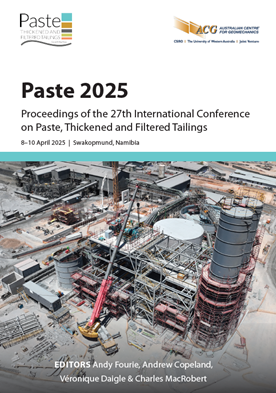The Radflow™ thickener feedwell: redefining thickener sizing and flocculant usage

|
Authors: Krassnokutski, A; Gillespie, M; Moodley, P-P |
DOI https://doi.org/10.36487/ACG_repo/2555_09
Cite As:
Krassnokutski, A, Gillespie, M & Moodley, P-P 2025, 'The Radflow™ thickener feedwell: redefining thickener sizing and flocculant usage', in AB Fourie, A Copeland, V Daigle & C MacRobert (eds), Paste 2025: Proceedings of the 27th International Conference on Paste, Thickened and Filtered Tailings, Australian Centre for Geomechanics, Perth, pp. 139-152, https://doi.org/10.36487/ACG_repo/2555_09
Abstract:
The development and successful application of the Radflow™ thickener feedwell by Roytec Global (Pty) Ltd. is explored, showcasing an advanced feedwell design that overcomes common thickener deficiencies. Utilising scale model methodologies and computational fluid dynamics (CFD), the Radflow feedwell demonstrates superior energy dissipation compared to standard industrial feedwells, optimising thickener performance. Two case studies, including one retrofit (to improve performance) and a new installation, validate the Radflow feedwell’s effectiveness. These cases highlight that traditional thickener design heuristics, specifically limiting rise rates and flux rates, are often overly conservative when an efficient feedwell design is applied. With Radflow-equipped thickeners, excessive flocculant addition becomes unnecessary, reducing operational costs and enhancing achievable underflow density. The findings advocate for relaxed scale-up safety factors in thickener design, allowing rise and flux rates closer to free settling rates observed in laboratory conditions when an optimised feedwell is utilised. This is particularly beneficial for processing slow-settling, challenging materials like clays and fine precipitates, where controlling flow dynamics is critical. Since thickener dimensions are often predetermined by external specifications, a secondary recommendation is to minimise flocculant dosing during commissioning. This reduces operational rise rates just below free settling velocities, which may be sufficient in conservatively sized thickeners. The argument can extend to a hypothetical extreme where certain conservatively sized or operated thickeners might operate without requiring flocculant, effectively functioning as conventional thickeners. Although this approach may not be practical or feasible for most thickening applications, there are cases where the use of polymer flocculants is undesirable. In these situations, the Radflow feedwell offers an effective solution through effective energy dissipation.
Keywords: feedwell, flocculant dosing, thickener sizing, thickener rise rate, thickener flux, Radflow feedwell
References:
David 2016, 'Measuring settling rates and calculating thickener capacity - 911Metallurgist,' 911Metallurgist,
Farrokhpay, S 2013, ‘The importance of rheology in mineral flotation: A review’, Minerals Engineering, vol. 36–38, pp. 272–278,
Fawell, PD, Brawner, SM & Swift, JD 2009a, ‘Feedwell performance: Understanding the important role of flocculant injection and distribution in thickening’, International Journal of Mineral Processing, vol. 93, no. 1, pp. 23–29.
Fawell, PD, Farrow, JB, Heath, AR, Nguyen, TV, Owen, AT, Paterson, D … & Usher, SP 2009b, ‘20 years of AMIRA P266 “improving thickener technology” — how has it changed the understanding of thickener performance?’, in R Jewell, AB Fourie, S Barrera & J Wiertz (eds), Paste 2009: Proceedings of the 12th International Seminar on Paste and Thickened Tailings, Australian Centre for Geomechanics, Perth, pp. 59–68,
Fawell, PD, Farrow, JB, Heath, AR & Swift, JD 2015, ‘The role of dilution water and feedwell design in thickening and flocculation’.
ThickenersClarifiers-brochure-FLSmidth-pdf.
Gladman, T, John, J & Young, S 2010, ‘The impact of feedwell design on flocculation and thickener performance’.
Jewell, RJ, ER Lord & Fourie, AB 2002, Paste and Thickened Tailings: A Guide, Australian Centre for Geomechanics, Perth.
Johnson, J & Accioly, A 2017, ‘Feedwell is the heart of a thickener’, in A Wu & R Jewell (eds), Paste 2017: Proceedings of the 20th International Seminar on Paste and Thickened Tailings, University of Science and Technology Beijing, Beijing, pp. 23–28,
Miller, M 2018, ‘Thickener design, control and development’, ALTA Conference, Perth.
Nguyen, TV, Farrow, JB, Smith, J & Fawell, PD 2012, 'Design and development of a novel thickener feedwell using computational fluid dynamics', in R Jewell, AB Fourie & A Paterson (eds), Paste 2012: Proceedings of the 15th International Seminar on Paste and Thickened Tailings, Australian Centre for Geomechanics, Perth, pp. 105–119,
1263_10_Nguyen
Perry, RH & Green, DW 2012, Perry's Chemical Engineers' Handbook, 8th edn, McGraw-Hill, New York.
Triglavcanin, R, Farrow, J & Heath, A 2013, ‘Feedwell improvements in thickeners: Balancing energy dissipation and distribution’.
Vietti, A & Dunn, F 2014, ‘A description of the sedimentation process during dynamic thickener operation’, Paste 2014: Proceedings of the Seventeenth International Seminar on Paste and Thickened Tailings, InfoMine, Vancouver, pp. 329–338.
Wills, BA & Finch, JA 2016, Mineral Processing Technology: An Introduction to the Practical Aspects of Ore Treatment and Mineral Recovery, 8th edn, Butterworth-Heinemann, Amsterdam.
Zhang, L, Liu, L, Zhang, J, Chen, Y, Liu, Z, Guo, M, Wang, X & Zhou, Y 2023, 'Effect of flocculant dosage on the settling properties and underflow concentration of thickener for flocculated tailing suspensions', Water Science & Technology, vol. 88, no. 1,
© Copyright 2025, Australian Centre for Geomechanics (ACG), The University of Western Australia. All rights reserved.
View copyright/legal information
Please direct any queries or error reports to repository-acg@uwa.edu.au
View copyright/legal information
Please direct any queries or error reports to repository-acg@uwa.edu.au
